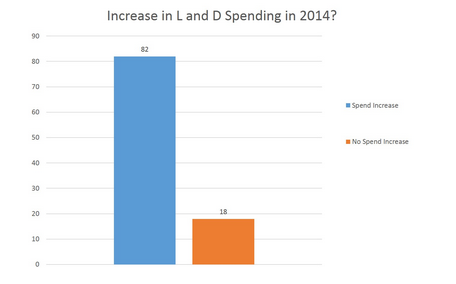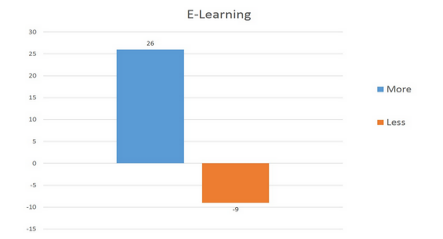Introduction
Training and development is an ongoing process in which efforts are made by the organizations to improve the performance of employees using various programs. In the current scenario, training and development are one of the most essential part of organizations (Training and development. 2015). The present study consists of training and development trends used in UK, theories, and concepts related to it and approaches with their impact on organizations. In the end, the study is concluded in the form of summary with key findings.
Training and Development Theories
With the change in working environment requirement of training and development has been increased for improvement and development of employees. As per the research of DeSario et.al 1994, “Training theories are designed for enhancing the employee's learning and developing opportunities” (DeSario et.al 1994). For delivering training to the team or staff members, the company should have proper knowledge of training theories for improving its effectiveness.
According to the Reigeluth, 2013, “Kirkpatrick's four-level training model can help organizations in an objective analysis of the effectiveness and impact of training to improve the present and future as well” (Reigeluth, 2013). In respect to this statement, Kirkpatrick's model consists of four stages which are reaction, learning, behavior, and results. By giving emphasis to each and every level as per the requirement of worker's learning needs, organization can enhance knowledge and skills with performance. In the context of above Dochy and et.al., 2012, have stated that “Reaction is important to measure as it helps the company in identifying impact and results of a training program. This makes the company to improve their training strategies for future trainees ” (Dochy and et.al., 2012). Similarly learning, behaviour and results helps organisation in finding their loopholes and effectiveness of training programmes. This theory results to better implementation of training and development programmes for the improvement of employees and firm as well.

Illustration 1: Fields of Training
On the other hand Peet and Hartwick, 2015, have asserted that “System model of training are more beneficial for improving the efficiency of employees” (Peet and Hartwick, 2015).This model has five phases which are analyse, design, develop, execute and evaluate. Firms can repeat this model for providing training on monthly basis as it gives perfect results and achieves the purpose of improvement and development of employees along their performance. In the contrast Edwards and et.al., 2013 have suggested that, “Instructional system development model is for solving the problems and issues arises during training programs” (Edwards and et.al., 2013). This model is widely used by companues now a days because in this training objectives are determined on the basis of job responsibilities, job description and employee's progress. It consists of five stages which are analysis, planning, development, execution and evaluation. Proper implementation of these theories during training and development activities can achieve expected results (Chand, 2015).
Approaches of Training and Development
According to the Van Den Akker and et.al., 2012, “Individuals require systematic development of their knowledge, skills and attitudes for performing their task effectively” ( Van Den Akker and et.al., 2012). For development of individuals its is important to use systematic approach for obtaining expected outcomes. These approaches design training and development programmes perfectly by planning each and everything properly. Ford, 2014, has stated that “Systematic training covers various stages which are inter related to each other. These stages are analysing training needs, setting objectives, designing training strategy, implementing strategy and validation” (Ford, 2014). By following above stages step by step organisation can fulfil its purpose behind the training programmes.
As the view point of Grossman, Heyne and Salas, 2014, “Training needs can be identified properly by using instruments which are proven for training needs analysis” (Grossman, Heyne and Salas, 2014). The first requirement of training approach is to analyse training needs and whole approach depends upon this first stage. So for finding appropriate needs organisations can use various techniques such as questionnaires, observation, feedbacks, face to face interview, etc. According to Meza and Mogos, 2013, “Systematic approach improves existing condition of organisations and provide them opportunities to enhance their market position” (Meza and Mogos, 2013). This approach impacts positively on working environment of company which improves HR functions and productivity as well. Improvement in firms increase improves their working styles and it increase their market value.
In contrast of above statement Khosla, 2015, has demonstrated that “Impact of training on enterprise depends upon the way approaches are implemented. Using right approach but implementing it in wrong manner will not provide required results” (Khosla, 2015). Proper designing and implementing leads to provide expected outcomes otherwise it is wastage of time and money which sometimes effects working of company and creates huge losses to it.
On the other hand, McGhee and Thayer 1961 suggest that, “Three fold approach is best approach for effectual training and development. This approach should be implemented by using three steps i.e. organisational analysis, task analysis and person analysis ” (McGhee and Thayer 1961). In respect to this approach, organisational analysis includes capability of company for conducting training programmes for improving employees performance and developing their personality.
In favor of above study Rosnati and et.al., 2015, have identified that “Three fold approach gives company an opportunity to update itself and its employees as per the market need and current acquirements” (Rosnati and et.al., 2015). In spite of all the above researches, Penny and et.al., 2015, have explored that “Training approaches can only give expected result, if they are implementing with proper training methods” (Penny and et.al., 2015). For getting appropriate results of training and development activities it is necessary to choose proper training method as per the requirement of an existing condition. Training methods include case study, lecture, discussions, role plays, brain storming, business games, programmed learning and many more.

Ration 2: Increase in Learning and Development
Similarly, Berlin, 2013, has found that “Companies have huge range of training methods for conducting effective training session. They can combine one or more training methods to make it more effective and beneficial for staff” (Berlin, 2013). It is the responsibility of firms to choose appropriate training method for enhancing the employee's skills and knowledge. It depends upon them how they can make training session interesting and learning for getting active participation from workers. As per the view of Ellinger and Kim, 2014, “Organisation can achieve growth by implementing this strategy and provide various learning opportunities to employees” (Ellinger and Kim, 2014). These approaches improves the performance of employees and increase the opportunities of career growth in the future.
Current Training trends in the UK
According to the Khosla, 2015, “Companies are finding new ways for increasing their capabilities and strengthens for facing challenges”(Khosla, 2015). With increasing opportunities challenges are also increasing and to face these challenges and to get full benefits of market opportunities, companies are implementing new and innovative techniques for improving their performance with employee development. Similarly Ford, 2014,found that “On the job training programmes and coaching by lie managers is one of the most effective strategy working for company's improvement from last five years” (Ford, 2014). The most expected changes in job performance are noted in last two years which are result of coaching technique. On the other hand Reigeluth, 2013, give more emphasis to e learning and state that “By combing e learning method with other methods companies can achieve their expected outcomes”(Reigeluth, 2013). e learning methods are increasing with the increasing use of internet and this method provide various learning opportunities to employees. This method is one of the common method now a days and has increased by 21%. For example, Reuters is the world's largest multimedia news agency which uses e learning method for train and develop their employees (2014 Survey on trends in learning and development. 2014).

Illustration 3: Percentage of e-learning method
In favour of above study Peet and Hartwick, 2015, identified that “Employees has claim that more learning and developing can be done socially by using social media and various applications”(Peet and Hartwick, 2015). Use of social media and applications are common now a days where people share their ideas and thoughts and learns new things. Proper use of these applications and social media sites can result to overall development of individuals. In oppose of the above statement Meza and Mogos, 2013, said that “e learning and Mlearning methods make employees to bring their own devices or make companies to purchase their own devices for training activities which effects economic status of employees and company” (Meza and Mogos, 2013). From a research it has been found that 25% of UK organisations are using blogs and social media sites for improving their training sessions (Training and development. 2015).
In the context of new training trends Rosnati and et.al., 2015, got that “UK companies are improving their efficiency by using flipped classrooms for train their employees” (Rosnati and et.al., 2015). In this technique, employees read the training material out of the classes ad then discuss it with each other and in the end apply those materials in the classrooms. It enhance various skills, creativity, innovativeness, communication skills, knowledge and information etc of staff members. From the research of Penny and et.al., 2015, it has found that “Only 8% companies thinks that their economic conditions are improved whereas half of the public and private sectors found reduction in their resources and funds which results to decrease in training spending ” (Penny and et.al., 2015). Average and small firms decrease their spendings on training by 12% and big organisations cut it by 5% in 2012. This makes large organisations to use cheaper techniques such as e learning. Similar to the above content Grossman, Heyne and Salas, 2014, said that “Leadership trainings are one of the popular training and 85% of companies said that they are going to continue leadership activities” (Grossman, Heyne and Salas, 2014). As per the same research, it is also found that only 6% companies do not want to continues and 10% firms do not know about this type of training. By improving skills and knowledge of leaders companies are lowering their barrier of internal coaching so that leaders becomes more capable of guiding their team members(Trends and emerging areas for learning and development. 2013).
In relation to the above evidence Edwards and et.al., 2013, demonstrated that “Internal factors of firms also effects the training and development process which includes 36% lack of senior management commitment, 33% cost and resource implications and 41% lack of knowledge about the impact of training and development ” (Edwards and et.al., 2013). Internal factors of firms need to be cooperative and should be aware about impacts of training sessions which helps in conducting proper training programs. In present scenario it has been found that organisations are suffering from capability gaps which includes analytical and technical skills along with lack of confidence in using technologies. In response to the above statement Grossman, Heyne and Salas, 2014, said that “For maximizing the values of company's investments they need to make sure that they have right skills at top place as importance of learning and development should not be underestimated” (Grossman, Heyne and Salas, 2014). By proper analysing the required skills and providing Training accordingly helps organisations in achieving their objectives and to compete with market. This is essential for the growth of employees and organisations as well.
According to Noe and et.al., 2014, “Coaching technique of training has gained popularity among UK companies in last ten years” (Noe and et.al., 2014). In respect of this, for growing coaching capabilities of any organisation, they need to determine firstly their motives for implementing this activity. They also need to be confirmed that coaching will make a performance difference and will give expected results. From the survey of Rosnati and et.al., 2015, it has been found that “56% organisations keeps learning and development strategy in written form which means that business managers and trainees do not have explicit clear and consistent reference point to check their own strategies” (Rosnati and et.al., 2015). In relate to this, documentation of training and development strategies helps organisations in comparing their past and present performance for determining level of improvement. With proper paper work, companies can keep a record of type of training, status of training, problems occurred during it, solutions used for resolving them, effective strategy, etc. As per the view of Dochy and et.al., 2012, “Adaptive learning is taking place in market for providing training to employees. This breaks the traditional models and allow employees to learn and develop them by their own” (Dochy and et.al., 2012). This methodology is gaining popularity in organisations as it provide opportunities for monitor them individually and to determine their learning needs which suits as per the current scenario (Wentworth and et.al., 2014.).
Conclusion
Training and development is one of the important part of any organisation for achieving growth and working according to the demand of time. Training and development consists of various theories which helps companies in achieving their objectives effectively. This also provides employee learning opportunities which increase their career growth and also makes them satisfied related to their job. With the changing time, market of UK is also changing which leads to use to new techniques and trends in training and development.
Students Also Like to Read: Business Environment UK College of Business Computing
References
- Berlin, M., 2013. 2 An overview of police training in the United States, historical development, current trends and critical issues. International Perspectives on Police Education and Training.
- Dochy, F. and et.al., 2012. Theories of learning for the workplace: Building blocks for training and professional development programs. Routledge.
- Edwards, R. And et.al., 2013. The learning society: challenges and trends. Routledge.
- Ellinger, A.D. and Kim, S., 2014. Coaching and human resource development examining relevant theories, coaching genres, and scales to advance research and practice. Advances in Developing Human Resources.
- Ford, J.K., 2014. Improving training effectiveness in work organizations. Psychology Press.
- Grossman, R., Heyne, K. and Salas, E., 2014. Approaches to Training. The Wiley Blackwell Handbook of the Psychology of Training, Development, and Performance Improvement.
- Khosla, S., 2015. Emerging Organisational Trends in Training & Development in India. Journal Of Business Management & Social Sciences Research.
- Meza, R. and Mogos, A., 2013. NEW TRENDS IN JOURNALISM CURRICULUM DEVELOPMENT. ROMANIA WITHIN THE INTERNATIONAL CONTEXT. Studia Universitatis Babes-Bolyai-Ephemerides.
- Noe, R.A. And et.al., Employee Development: Issues in Construct Definition and Investigation ofAntecedents. Improving Training Effectiveness in WorkOrganizations, ed. JK Ford, SWJ Kozlowski, K. Kraiger, E. Salas, and MS Teachout (Mahwah, NJ: Lawrence Erlbaum, 1997),
- Peet, R. and Hartwick, E., 2015. Theories of development: contentions, arguments, alternatives. Guilford Publications.



















